
Sales play a key role in the success of any business. Likewise, the sales team is the heart of any organization. They not only increase revenue but also build strong customer relationship.
Whether you are a sales leader or a salesperson of a company, the objective is always to close a deal. But, no company is exempt from sales challenges. Even the most high-performing sales team faces lots of difficulties to effectively communicate with prospects and turn potential leads into paying customers.
What makes successful companies unique, is their ability to overcome these challenges. You need different skills to overcome these challenges. However, without having a robust sales process it will be harder for your sales team to be successful in winning customers.
What is a sales process?
A sales process is a repeatable set of steps that a sales team can perform to turn potential leads into paying customers. It acts as a roadmap for your sales team so they can know what steps to take next, to close a deal.
Why do you need a sales process?
Having a sales process can bring value to your business in many ways including increasing clarity, improving your team’s efficiency, increased revenue and consistent improvement. Regardless of the age or size of your business, it can have a positive impact on the sustainability of your business. Given the fact that a sales process provides more benefits, almost all the companies across the world are making it a priority to have proper process.
What are the stages of a sales process?
Typically, a sales process consists of 7 stages Prospecting, Qualifying Prospect / Need Assessment, Demo Meeting, Product or service evaluation, Handling objections, Closing and Fostering strong relationship.
7 Steps in a Sales Process
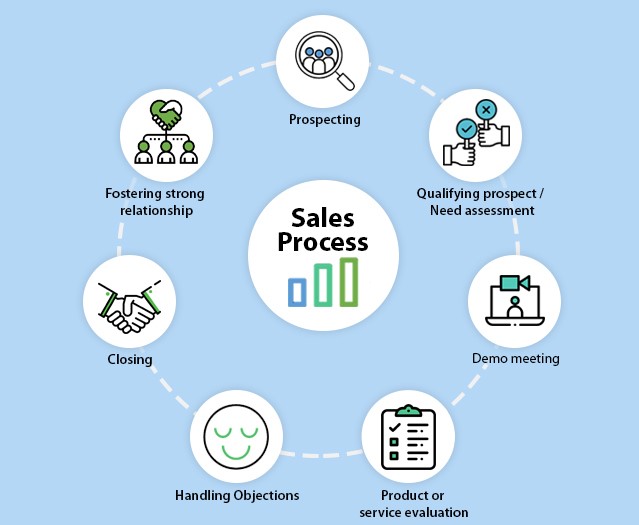
1. Prospecting

Prospecting is the first step in the sales process. It is the process of finding potential customers for your business. One of the most important aspect of effective prospecting is identifying good-fit customers for your business. To find prospects who are interested in your product, you need to create Ideal Customer Profile (ICP) that helps you to distinguish which person / company is most likely to do business with you for long. The best way to do this is by doing a market research and collecting real data about your existing and future customers. Once you create a profile, you can share it with your sales team.
The sales team can then create a strategy to reach the potential customers employing various prospecting methods including social media, networking events and trade shows, email and website.
Once you grab your prospects attention, you will need to make initial contact with them via phone or email to understand their needs and to build a strong relationship with them.
To get in touch with the right prospects quickly and efficiently, you need to establish a step-by-step sales prospecting process that works for you and your sales team. Here are five steps you can follow to approach your prospect.
Sales prospecting process
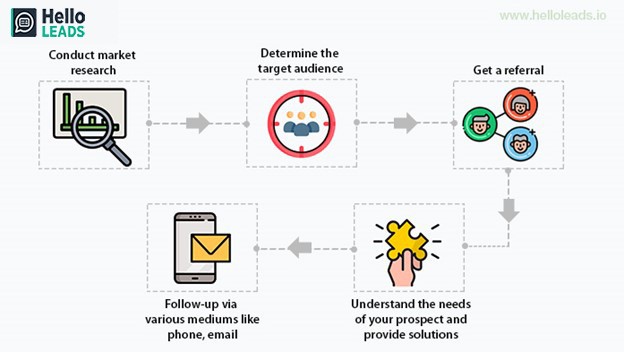
2. Qualifying prospect / Need Assessment
Qualifying a prospect is the next step in your sales process. Determining whether or not the prospect is a good fit as a customer is important as it will save your time and effort to turn them into a customer.
There are several methodologies to qualify a prospect including BANT (Budget, Authority, Need, Timescale), MEDDIC (Metrics, Economic Buyer, Decision Criteria, Decision Process, Identify Pain, Champion) and CHAMP (CHallenges, Authority, Money, Prioritization) Sales. To qualify a prospect, you can asks questions related to budget, authority, need and timeline.
When your prospect is qualified as a good fit customer, you may proceed with needs assessment. You can further initiate a phone call or organize for a face-face meeting with the prospect to understand if your product / service can solve their challenges. You can ask questions such as
- Why weren’t you happy with your last vendor?
- What business problem are you hoping we’ll be able to solve?
- What are your top priorities in a solution?
- What is your current expectations?
To ensure that the prospect and salesperson are in the same page, salesperson can confirm their understanding of what the prospect told them. Once their need is clear you can proceed with the next step.
3. Demo Meeting

In this stage after the need assessment, you can schedule a demo call with your prospect. During the call, you can clearly communicate how your product or service meet their needs. You can actively demonstrate the features and benefits of your product / service offerings connecting with their needs. Always, ensure that you actively listen to your customer’s needs and react accordingly.
Here are some best demo practices to improve your sales.
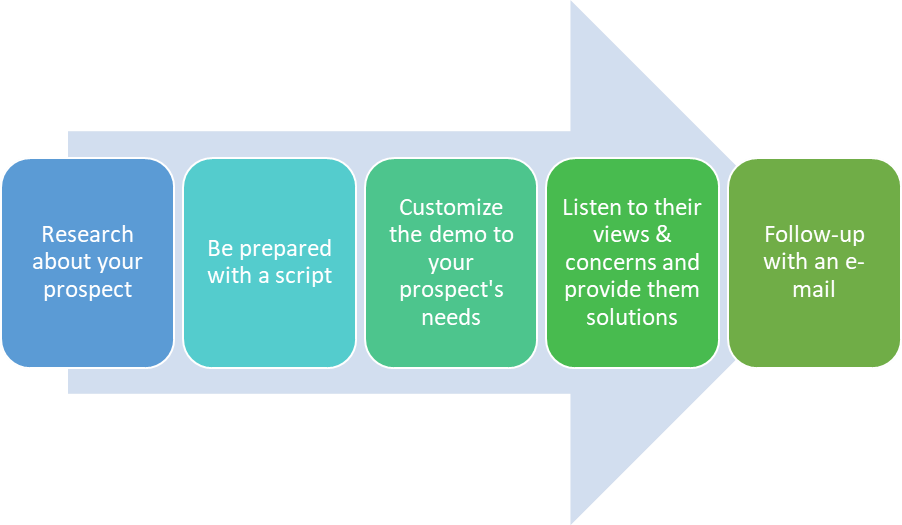
When done correctly, a demo allows the customer to see and feel how things will be better if they buy your product / service. Hence it is important to host a successful sales demo to close a deal.
4. Product or service evaluation
Product or service evaluation is a trial stage where you can provide the customer with product / service experience (e.g. a free 14 day trial) that is designed to prove that the product or service will meet the buyer’s objectives. A crucial part of sales process is to make it easy for the customer to undertake an evaluation of your product or service. You can even provide the premium features of your product which will help customers to evaluate your product as whole.
In this stage it is good to stay in touch with the customer to ensure that they buy your product / service.
5. Handling objections
When it comes to objection handling in sales, when a prospect comes back with various objections, the best course of action is to stay calm, understand the objection completely and respond to it properly. Though it is difficult to handle, objections are actually a positive sign that the process is moving forward. Once the customer is convinced of the value you are offering, you have successfully handled the objection and can move toward a purchasing decision.
Here are 4 steps to overcome sales objections and close a deal.
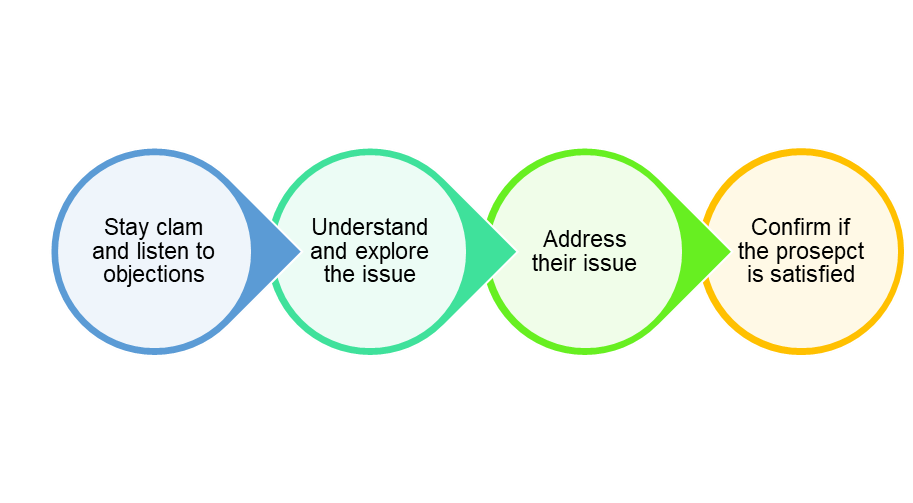
6. Closing
Closing a sale is one of the most important stages of selling where the sales person takes action to gain agreement to the sale. This stage includes activities like signing contacts, pricing discussion and any other additional paperwork. This stage may also involve introductions to team who will be handling further processes. And now the prospect is your customer!!!

7. Fostering strong relationship
The sales process does not end up after you close a deal. Building and developing relationship with potential customers results in repeated business. Keeping your customers updated about new services can make the customer to buy higher plan or even refer your product or service to other businesses.
By maintaining strong customer relationships, you can improve sales and generate more business easily.
To conclude, an effective sales process shows a clear path for sales team to follow and gives them much more consistency in winning deals.
Share this blog :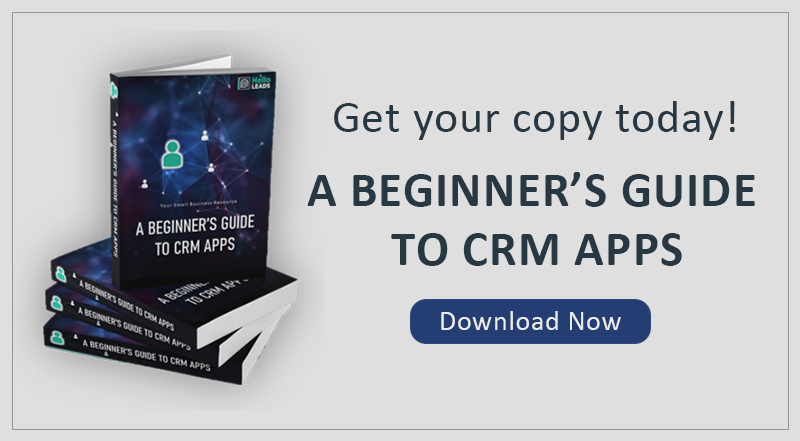

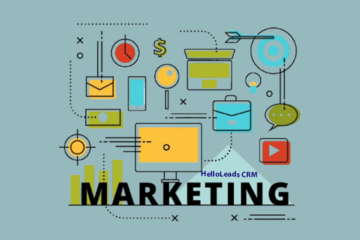










Well-researched and informative post. Thanks for sharing!
Thanks for sharing this informative and well-structured blog post. The topic you covered is relevant, and your explanations were clear and concise.
Your post offers a unique perspective that challenges the status quo. It’s refreshing and thought-provoking.
Thank you for sharing this insightful and well-written blog post. The clarity of your writing made it easy for me to understand the concepts, and I appreciated the actionable advice you provided.